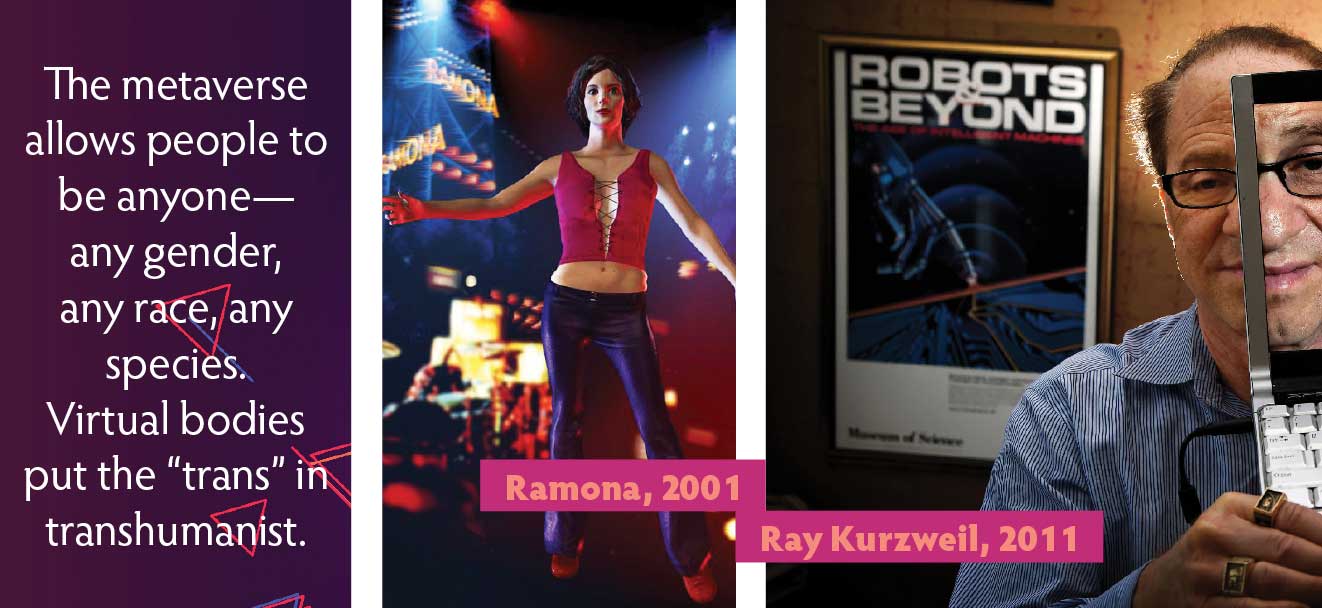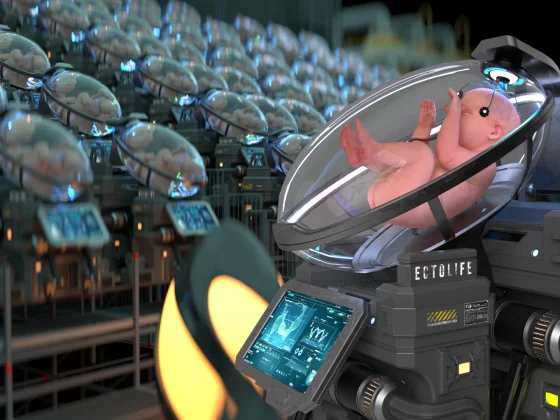As the name implies, the goal of transhumanism is to transform humans into superbeings through technology. The biological contingency of one’s sex or race, the physical limitations of one’s location, the peculiarities of one’s unique aptitudes—all of these can be transcended as if life is but a dream. As with all delusional ideas, the end result will be disastrous.
Ray Kurzweil, the Google-sanctioned prophet of this techno-cult, predicts that by 2045 we’ll hit the Singularity—when tech has advanced beyond human reason or control. Our souls will exist in a liminal state between the physical and digital worlds. When the metaverse went mainstream last year, it appeared to fulfill yet another of his dismal prophecies.
“The Singularity will represent the culmination of the merger of our biological thinking and existence with our technology,” he foretold in his 2005 scripture, The Singularity Is Near:
There will be no distinction, post-Singularity, between human and machine or between physical and virtual reality. . . . [O]ur experiences will increasingly take place in virtual environments. In virtual reality, we can be a different person both physically and emotionally. In fact, other people (such as your romantic partner) will be able to select a different body for you than you might select for yourself (and vice versa).
More sober voices in the transhumanist movement approach Kurzweil’s predictions with caution. The same goes for futurists who avoid the “trans-” moniker altogether. Despite their reservations, they’re all facing the same direction. One way or another, we’re gonna fuse with machines.
“VR isn’t simply a new form of media; it sweeps away the barriers of all previous forms,” Wired editor Peter Rubin evangelized in his 2018 book Future Presence.” [W]e have the ability to become the art—to be part of a world, even to be a character. . . . [I]t promises to upend every industry you can name.”
The metaverse couldn’t have come at a better time. As real-life droids take over decent jobs, unemployed schmoes can shoot at robots in virtual reality. A population lost in digital hallucinations doesn’t need brain implants or drugs to keep them pacified. If the VR realm is fun enough, people will keep themselves on lockdown.
Clawing for ZuckerBucks
Ever since Facebook staked its claim on the metaverse, countless tech companies have tossed their brainscan helmets in the ring. Microsoft is hyping its own virtual workspace. Roblox is enticing youth with advanced virtual reality games. Reddit’s KarmaLab is coaching companies to thrive in meta-space. Nvidia is offering up custom avatars. Companies like The Sandbox are selling virtual real estate as NFTs (“non-fungible tokens,” i.e., digital assets).
All across Asia, virtual influencers—computer-generated popstars whom fans adore like real people—are preparing to take the metaverse stage. In China, the tech giant Baidu just unveiled its new metaverse design, called “The Land of Promise.” From east to west, Wall Street investors are pouring gazillions into this lunacy. Big capital ensures its development in some form or another, however corny it turns out to be.
For those who enter the metaverse through high-end equipment, I have no doubt the experience will be thrilling. There will be fantastic adventures in alien environments, epic battles as robots or wizards, and whole battalions of gametes lost to first-person 360° porn.
That thrill is the first major problem. After decades of goofy graphics and simulation sickness, VR is now officially awesome. Just as LSD molecules will slide right into your serotonin receptors, easy as you please, the new head-mounted displays trick the brain into experiencing a virtual world as if it were real. VR fans call this state “presence.”
Stereoscopic screens and precision headphones create the illusion of depth. Because these visual and audio fields track with your physical body’s motion—detected by external cameras and synced with onboard gyroscopes and accelerometers—you become “embodied” in the VR experience. Add in artificial genitals, and there goes your weekend. Fast-forward a decade or three, and there goes a future generation.
“Given VR’s mind-bending capacity to elicit emotional reactions with a simulation, intimacy can be found with a program or a recording,” Rubin exults in Future Presence. “[T]he emotional, cognitive, and psychological reactions we have in virtual worlds promise to change us in some fundamental ways.”
The second problem, which will afflict millions, is a chronic disassociation from one’s body and culture. Kissing an actual woman may be scary at first, but it’s certainly worth the risks and fumbles. It just takes a little practice. The same is true of brawling, mountaineering, or climbing a vaulting steel structure. These sorts of rough-and-tumble pastimes turn boys into men. But you have to get physical.
On the other end, girls have their own rites of passage—deeply embodied—that transform them into mature women. In a compassionate society, sissies and tomboys also have their roles to grow into.
But in the shadow of a global metaverse, crowded with fake personas to inhabit, these organic identities can easily be wiped away.
To the extent augmented and virtual reality become a primary mode of experience—and that’s definitely the plan—the metaverse will leave young people atrophied and unprepared to confront the real world head-on. VR creators and ad-men already know that, but detachment from reality isn’t just part of their business model. It’s a religious conviction.
Inside the Transhuman Mind
Of all the weird quirks Ray Kurzweil exhibits—and we’re talking about a long list—his fetish for becoming a woman in virtual reality is at the top. Back in 2001, he appeared onscreen at a TED Talk as “Ramona,” an electronic trollop who sings and dances. While Kurzweil performed Jefferson Airplane’s “White Rabbit” (as Ray onstage, as Ramona onscreen), his teenage daughter boogied in the background as a digital dude.

“The experience was a profound and moving one for me,” he recounted in The Singularity Is Near. “When I looked in the ‘cybermirror’ . . . I saw myself as Ramona rather than the person I usually see in the mirror. I experienced the emotional force—and not just the intellectual idea—of transforming myself into someone else.”
Five years later, he did a spot on C-SPAN as his alter-ego. Speaking in a Southern drawl, “Ramona” lamented that, unlike Ray, her ex-boyfriends had killed off the diverse personalities bubbling up in their brains.
Kurzweil looks forward to the Singularity, some two and a half decades away, when people are finally “liberated” from their birth bodies to take on a rainbow of immortal avatars. This will occur in virtual space, he believes, but also out in the real world through pills, injections, bionic implants, blood-borne nanobots, and other perverse technologies.
This gender-bending, borderline schizophrenic desire is a hallmark of the techno-cult. In his (her?) 2013 essay “Transavatars,” William Sims Bainbridge wrote:
True transhumanism does seek to enable each of us to alter and improve (by our own standards) the human body and champions morphological freedom [including to] be able to inhabit different bodies, including virtual bodies. . . . Avatars point out to us that enhancement is not merely a matter of increasing the effectiveness of a person in taking action, but also can mean an altered form of consciousness that expands opportunities for experiences, and escape from the conventional system of moral restraints.
When God is dead, everything is permitted—and may be free to download. In 2015, the wild prodigy R. U. Sirius drew back the curtain on this loosey-goosey mindset in Transcendence: The Disinformation Encyclopedia of Transhumanism and the Singularity:
As we move into an age of shifting identities, where we can be whatever or whoever we choose to be in our virtual lives, where biotechnology may soon offer changes in skin melanin bringing about the age of the trans-racial, as people start to evolve novel body ornamentations and eventually parts, as we learn how to control our hormones to amp up our estrogen or testosterone to suit the needs of the day, we should always remember to thank the transgendered.
Bodies with No Soul
In the metaverse, you can be whoever you want to be. Keeping with the times, that fact was construed as a social-justice issue by the once-respectable MIT Technology Review. In a recent article entitled”The Metaverse Is the Next Venue for Body Dysmorphia Online,” author Tanya Basu frets that women will be self-conscious about their pudgy avatars in the metaverse. Fortunately, a virtual environment could also allow a woman who identifies as a “fat, gay, pre-medical-transition trans man” to find validation; as one interviewee told Basu, “For me, the joy of seeing myself represented accurately would mean that I am not the only person who believes my existence is valid. It means a team of developers also see the potential of me existing, as I look, as a man.”
As if PC speech codes and expensive medical procedures weren’t enough, soon we’ll have a vast electronic infrastructure to coddle delusional minds. You can be certain that, just as social media and 24/7 screen time induces teen gender dysphoria, the madhouse of the metaverse will extend identity crises to cartoon teddy bears and polymorphic aliens.
Virtual reality is yet another jewel in the crown of King Crazy. Its primary function is to allow people to forget who they are and where they come from. Yes, the miracles of technology allow for infinite possibilities. But at least half of them are ridiculous.
Unlike great films or fine literature, which trigger memory and help people interpret the real world, VR offers a universe unto itself—one devoid of sentience and soul. Those who get lost in this lifeless abyss will have no idea where they’re going, out in reality, and no means to control their lives beyond the imaginary powers they’ve been sold.
As with most delusional states, their madness will seem to have no consequence at first. It’ll be hidden behind plastic goggles and closed doors. Normal people can look the other way and hum right along, as they did with the race riots, opioid addictions, smartphone schizoids, and toddler boys in dresses. But as more and more vulnerable souls retreat into immersive worlds, losing themselves in preposterous scenarios behind phony digital masks, their minds will become unglued. Real relationships will dissolve.
Eventually, reality will come crashing down with devastating force. By that time, everyone who invested in the metaverse will have made his millions. If the Machine ever runs out of steam, all we’ll have is each other. Better hold on tight.
There Is No Escape
Physical existence is where embodied souls are formed. It’s the high-stakes arena where personal strength and moral fiber are tested. It’s hard to believe, but digital natives will sincerely ask, “What’s so great about the ‘real world,’ anyway? Why bother?” After contemplating life’s challenges and tragedies, people won’t find it easy to give a solid answer. Hypocrisy is just one snide remark away.
When life kicked me in the teeth as a kid, I either escaped into the forest or into literature and film. Being young, my imagination ran away with me sometimes, but the best books and movies inspired me to go out and live. Art inspired me to climb mountains and steel girders, to fight back, to kiss girls, to be wildly generous or unforgivably mean—to drag my carcass out the door and explore the world. Art inspired me to take risks and refine living into an art form, however absurd those pieces turned out to be.
True art can’t be reduced to the “virtual.” It isn’t vicarious satisfaction. True art evokes envy and ambition. The highest art demands reverence, even devotion. When that reverential awe becomes shared inspiration, great art can transform entire cultures. Purely digital space, so far as I can tell, is a vortex flowing in the other direction. Anyone close to a diehard gamer knows that even the best virtual art will create a vacant husk that smells like fart residue and Dorito dust.
Real life is difficult, though, and it’s dangerous. When a young person asks, “Why endure ‘real life’ instead of enjoying virtual reality?”, he might as well be asking, “Why not enjoy heroin while it’s still cheap?” You’d be lying to say escape isn’t easier.
The honest answer to those questions is: “Duty.” You must confront the outside world to become a responsible adult. You must become a responsible adult to confront the outside world. It’s not a tautology. It’s a feedback loop.
We’re called to struggle through this fallen world, to steel ourselves against its cruelties, to reach out and pull others along as best we can. Any diversion from that calling, any crippling pleasure, is a sin against our nature. We simply are who we are—born male and female, born of certain bloodlines, born in particular places and at particular times. We’re spirits refined through bodily trials.
That isn’t an easy answer to accept. It isn’t even a rational one. But in the end, duty endures beyond pleasure and pain. Generation after gritty generation, we’re called upon to love, to negotiate, to fight. Victory is never assured, but defeat is certain for those lost to fantasy—especially when those delusions are strapped to your face.














